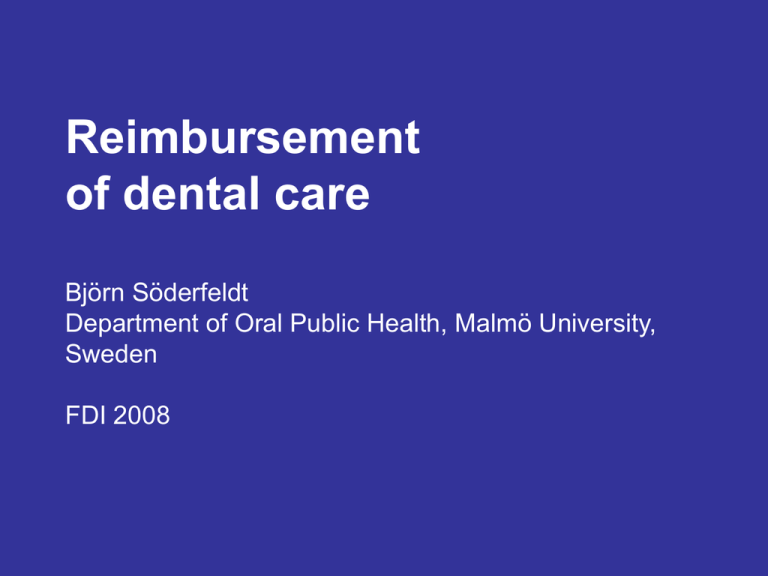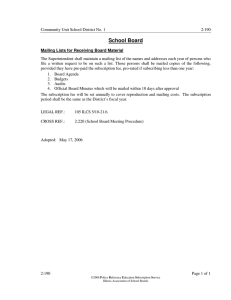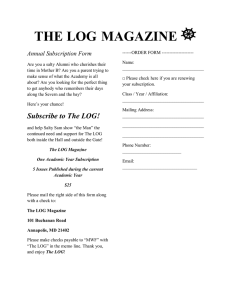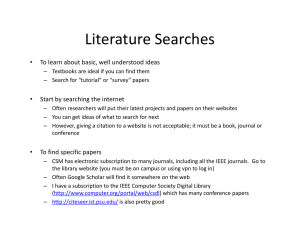(PowerPoint-dokument, öppnas i nytt fönster) (PowerPoint-dokument, öppnas i nytt fönster)
advertisement

Reimbursement of dental care Björn Söderfeldt Department of Oral Public Health, Malmö University, Sweden FDI 2008 Three basic systems in reimbursement of dental care: • Fee-for-service (FFS) • Capitation (CAP) • Salary (private or National Health Service) The systems are analytical categories and can be combined in many ways. They can also be combined with Third-party-payment (TPPS) in insurance systems, and with Patient payment systems (PPS) Patient payment system: The patient pays before or after treatment Subscription care: The patient pays a set fee in advance for dental care during a given time period, according to a risk classification. Can be combined with CAP The various European models for dental care have different combinations of the systems. FFS is the rule for adults with varying access to salaried public systems. CAP as a system occurs primarily in child care (Widström, Eaton 2004) There are theoretical pros and cons for all systems (Grytten 2005): • FFS Assures quality Nonselective Market imperfections impair cost-effectiveness Opens for supplier-induced demand “Overtreatment” ? • CAP High effectiveness Equality in access High administration costs Patient selection Under-treatment ? • Salary Predictable cost No money in patient contacts Low efficiency Low productivity In public systems: fiscal problems There is no “best” system!! However, should systems be judged only by efficiency or productivity? There are also moral aspects!! Dentistry is a human service occupation, and as all human services, it is morally founded. The core of the work is THE CLINICAL ENCOUNTER The clinical encounter Gender Age Training Personality Dentist Care organization Work load Control over work Financing system Clinical judgment E n c o u n t e r Gender Age Experience Personality Health Fear Selfesteem Patient Social class Education Resources Ethnicity What is the moral aspect of the encounter? Dental care is a GOOD that should be distributed. The discourse of distributive justice in moral philosophy is therefore relevant. (Miller “Social Justice” 1985) RIGHT You should have something good because you are entitled to it according to law, agreement or natural rights The basic principle of bureaucracy In CAP, you acquire a right to care, most obviously in subscription systems VIRTUE You should have something good because you deserve it, due to virtue or payment The basic principle of the market In FFS, you are entitled to care if you pay for it NEED You should have something good because you need it Three kinds of need: 1. Subjective need - only the shoe wearer knows where it pinches 2. Objective need - someone else decides what you need 3. Emancipatory needs - the perception of needs depends on the perceived opportunities for realization In public salaried systems, it can be possible to set need as distributive principle The clinical encounter revisited Professional Patient Objective need Emancipatory need Right Virtue Subjective need Bureaucrat Supermarket Schlaraffenland Therapy bureaucrat Human being Citizen Customer Spoiled child Professional patient Human being Basic hypothesis Harmony when relations are congruent Disharmony and conflict when incongruent Theory is nice, but evidence is scarce. In a comprehensive review of 2507 articles, aiming to find system comparisons, Johansson et al (2007) found: • A long-term tendency of decreased caries incidence in CAP • CAP decreases restorative treatments • CAP increases preventive care, mainly preventive advice and fissure sealants • Productivity does probably not decrease with CAP • Neither does dentist nor patient satisfaction Great uncertainty and limited materials A recent contribution: An evaluation of subscription care vs. FFS in a salaried system in the county of Värmland, Sweden, as to the effects on oral health (Johansson et al 2007) The Public Dental Service in the county of Värmland introduced subscription care 1999. A comparative survey was done 2003 on 1324 patients (sample 2400, response rate 57 %). OHIP-14 used to measure oral health, SF-36 for general health Bivariate analysis Johansson et al. Patients’ health in contract and fee-for-service care. I. A descriptive comparison. Swed Dent J. 2007; 31: 27-34 Demographic differences Subscription care FFS • Mean age: 42 yrs (SD 13) • Mean age: 52 yrs (SD 17) – Range: 21-87 yrs • • • • • 96 % born in Sweden 76 % married/cohab 14 % elem educ 35 % college 42 % high affinity to neighborhood – Range: 21-89 yrs • • • • • 91 % born in Sweden 70 % married/cohab 36 % elem educ 22 % college 49 % high affinity to neighborhood Significant differences, p<0.05 Oral health related quality of life (OHIP-14), index Range: 0-56 Low value, better oral health related quality of life Subscription care FFS • • • • • • • • Mean= 4.9 CI 95%=4.53-5.33 SD=5.3 Median= 4.0 Mean= 6.9 CI 95%=6.22-7.54 SD=8.3 Median= 4.0 Significant difference, p=0.019 OHIP-14, dimensions Subscription FFS (680≤n≤684) (616≤n≤624) Mean (SD) Mean (SD) p Functional limitation 0.3 (0.8) 0.6 (1.3) <0.001 Physical pain 1.9 (1.5) 2.2 (1.8) 0.023 Psychological troubles 1.1 (1.5) 1.4 (1.9) 0.063 Physical disability 0.3 (0.8) 0.7 (1.3) <0.001 Psychological disability 0.7 (1.1) 1.0 (1.5) 0.003 Social disability 0.2 (0.7) 0.4 (1.0) 0.007 Handicap 0.3 (0.8) 0.6 (1.2) <0.001 Dimension General health (SF-36), dimensions Subscription FFS (678≤n≤685) (604≤n≤628) Dimension Mean (SD) Mean (SD) p Physical function 92.7 (13.6) 84.6 (21.8) <0.001 Role function-physical 84.5 (29.6) 77.0 (36.6) 0.002 Pain 77.1 (24.1) 74.5 (26.8) 0.221 General health 78.0 (19.1) 72.4 (21.9) <0.001 Vitality 64.6 (23.2) 65.3 (24.9) 0.267 Social function 87.8 (19.6) 84.9 (22.4) 0.045 Role function-emotional 84.7 (30.3) 83.1 (32.9) 0.570 Psych well-being 79.0 (18.2) 78.5 (18.9) 0.962 Multivariate analyses Johansson et al. Multivariate analyses of patient financial systems and oral health-related quality of life. Submitted manuscript Regression models Dependent variable: OHIP-14 Range: 0-56 p≤0.001 fo all models Variable Finance system Model 1 Finance system: FFS (vs. subscription) 1.95 Adj R2 0.02 Variable Model 2 Finance system Finance system: FFS (vs. subscription) 1.40 Economic factors Willingness to pay (11 categories)* -0.26 Paid previous year (11 categories)* 0.96 Adj R2 0.08 * Reference category: ”0-500”. Range: 0-5 001 SEK or more Variable Model 3 Finance system Finance system: FFS (vs. subscription) 1.62 Economic factors Willingness to pay (11 categories) -0.24 Paid previous year (11 categories) 1.00 Sex: Woman (man) 0.55 Age (21-89) -0.02 Adj R2 0.08 Individual factors Variable Model 4 Finance system Finance system: FFS (vs. subscription) 1.28 Economic factors Willingness to pay (11 categories) -0.20 Paid previous year (11 categories) 0.97 Sex: Woman (man) 0.54 Age (21-89) 0,03 Birth country: Other (Sweden) 4.11 Marital status: Single (married/cohab) 0.75 Education: Secondary (elementary) -1.11 Individual factors Social factors College (elementary) -0.77 Social anchorage (2-8) 0.30 Adj R2 0.11 Variable Model 5 Finance system Finance system: FFS (vs. subscription) 0.89 Economic factors Willingness to pay (11 categories) 0.00 Paid previous year (11 categories) 0.74 Individual factors Sex: Woman (man) Age (21-89) -0.11 0,03 Finance system Finance system: FFS (vs. subscription) -0.02 Social factors Birth country: Other (Sweden) 2.97 Marital status: Single (married/cohab) 0.89 Education: Secondary (elementary) -0.87 College (elementary) Psychological factors -0.15 Social anchorage (2-8) 0.17 Dental Anxiety Scale (4-20) 0.37 Humanism Scale (8-40) -0.09 Self-esteem Scale (6-24) -0.37 MHLC – Powerful others (2-10) 0.14 MHLC – Internal (2-10) 0.01 MHLC – Chance (2-10) 0.23 Adj R2 0.18 Variable Model 6 B0 13.49 Finance system Finance system: FFS (subscription) 0.92 Economic factors Willingness to pay (11 categories) 0.04 Paid previous year (11 categories) 0.70 Sex: Woman (man) -0.02 Age (21-89) -0.01 Birth country: Other (Sweden) 2.90 Marital status: Single (married/cohab) 0.40 Education: Secondary (elementary) -0.65 Individual factors Social factors College (elementary) Psychological factors Health factors 0.14 Social anchorage (2-8) 0.10 Dental Anxiety Scale (4-20) 0.25 Humanism Scale (8-40) -0.09 Self-esteem Scale (6-24) -0.13 MHLC – Powerful others (2-10) -0.01 MHLC – Internal (2-10) 0.15 MHLC – Chance (2-10) 0.21 Sense of coherence (20-91) -0.08 SF-36 Physical component (PCS) (9.51-71.04) -0.08 SF-36 Mental component (MCS) (-0.12-69.66) -0.08 Adj R2 0.23 Cautious conclusion about Värmland: There may be characteristics in the subscription care system itself that have positive impact on oral health General conclusions: 1. No possible evidence-based system recommendations 2. Systems should be evaluated as to their effects on health 3. Dentistry is not only production but primarily CARE 4. More research needed with a comprehensive perspective THANK YOU FOR YOUR ATTENTION! Bjorn.Soderfeldt@mah.se



